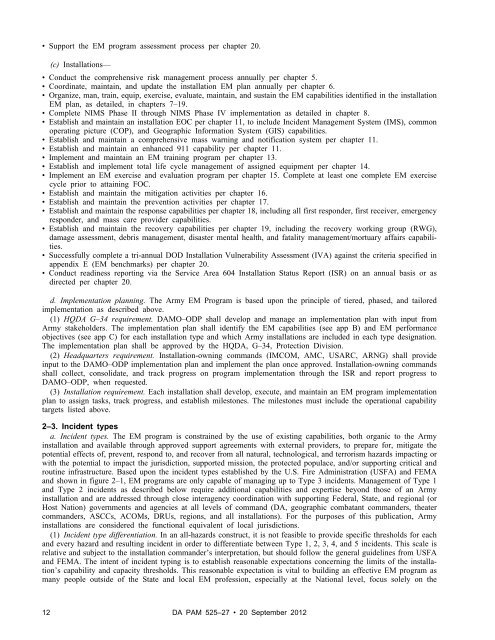Army Emergency Management Program - Federation of American ...
Army Emergency Management Program - Federation of American ...
Army Emergency Management Program - Federation of American ...
You also want an ePaper? Increase the reach of your titles
YUMPU automatically turns print PDFs into web optimized ePapers that Google loves.
Support the EM program assessment process per chapter 20.<br />
(c) Installations—<br />
Conduct the comprehensive risk management process annually per chapter 5.<br />
Coordinate, maintain, and update the installation EM plan annually per chapter 6.<br />
Organize, man, train, equip, exercise, evaluate, maintain, and sustain the EM capabilities identified in the installation<br />
EM plan, as detailed, in chapters 7–19.<br />
Complete NIMS Phase II through NIMS Phase IV implementation as detailed in chapter 8.<br />
Establish and maintain an installation EOC per chapter 11, to include Incident <strong>Management</strong> System (IMS), common<br />
operating picture (COP), and Geographic Information System (GIS) capabilities.<br />
Establish and maintain a comprehensive mass warning and notification system per chapter 11.<br />
Establish and maintain an enhanced 911 capability per chapter 11.<br />
Implement and maintain an EM training program per chapter 13.<br />
Establish and implement total life cycle management <strong>of</strong> assigned equipment per chapter 14.<br />
Implement an EM exercise and evaluation program per chapter 15. Complete at least one complete EM exercise<br />
cycle prior to attaining FOC.<br />
Establish and maintain the mitigation activities per chapter 16.<br />
Establish and maintain the prevention activities per chapter 17.<br />
Establish and maintain the response capabilities per chapter 18, including all first responder, first receiver, emergency<br />
responder, and mass care provider capabilities.<br />
Establish and maintain the recovery capabilities per chapter 19, including the recovery working group (RWG),<br />
damage assessment, debris management, disaster mental health, and fatality management/mortuary affairs capabilities.<br />
Successfully complete a tri-annual DOD Installation Vulnerability Assessment (IVA) against the criteria specified in<br />
appendix E (EM benchmarks) per chapter 20.<br />
Conduct readiness reporting via the Service Area 604 Installation Status Report (ISR) on an annual basis or as<br />
directed per chapter 20.<br />
d. Implementation planning. The <strong>Army</strong> EM <strong>Program</strong> is based upon the principle <strong>of</strong> tiered, phased, and tailored<br />
implementation as described above.<br />
(1) HQDA G–34 requirement. DAMO–ODP shall develop and manage an implementation plan with input from<br />
<strong>Army</strong> stakeholders. The implementation plan shall identify the EM capabilities (see app B) and EM performance<br />
objectives (see app C) for each installation type and which <strong>Army</strong> installations are included in each type designation.<br />
The implementation plan shall be approved by the HQDA, G–34, Protection Division.<br />
(2) Headquarters requirement. Installation-owning commands (IMCOM, AMC, USARC, ARNG) shall provide<br />
input to the DAMO–ODP implementation plan and implement the plan once approved. Installation-owning commands<br />
shall collect, consolidate, and track progress on program implementation through the ISR and report progress to<br />
DAMO–ODP, when requested.<br />
(3) Installation requirement. Each installation shall develop, execute, and maintain an EM program implementation<br />
plan to assign tasks, track progress, and establish milestones. The milestones must include the operational capability<br />
targets listed above.<br />
2–3. Incident types<br />
a. Incident types. The EM program is constrained by the use <strong>of</strong> existing capabilities, both organic to the <strong>Army</strong><br />
installation and available through approved support agreements with external providers, to prepare for, mitigate the<br />
potential effects <strong>of</strong>, prevent, respond to, and recover from all natural, technological, and terrorism hazards impacting or<br />
with the potential to impact the jurisdiction, supported mission, the protected populace, and/or supporting critical and<br />
routine infrastructure. Based upon the incident types established by the U.S. Fire Administration (USFA) and FEMA<br />
and shown in figure 2–1, EM programs are only capable <strong>of</strong> managing up to Type 3 incidents. <strong>Management</strong> <strong>of</strong> Type 1<br />
and Type 2 incidents as described below require additional capabilities and expertise beyond those <strong>of</strong> an <strong>Army</strong><br />
installation and are addressed through close interagency coordination with supporting Federal, State, and regional (or<br />
Host Nation) governments and agencies at all levels <strong>of</strong> command (DA, geographic combatant commanders, theater<br />
commanders, ASCCs, ACOMs, DRUs, regions, and all installations). For the purposes <strong>of</strong> this publication, <strong>Army</strong><br />
installations are considered the functional equivalent <strong>of</strong> local jurisdictions.<br />
(1) Incident type differentiation. In an all-hazards construct, it is not feasible to provide specific thresholds for each<br />
and every hazard and resulting incident in order to differentiate between Type 1, 2, 3, 4, and 5 incidents. This scale is<br />
relative and subject to the installation commander’s interpretation, but should follow the general guidelines from USFA<br />
and FEMA. The intent <strong>of</strong> incident typing is to establish reasonable expectations concerning the limits <strong>of</strong> the installation’s<br />
capability and capacity thresholds. This reasonable expectation is vital to building an effective EM program as<br />
many people outside <strong>of</strong> the State and local EM pr<strong>of</strong>ession, especially at the National level, focus solely on the<br />
12 DA PAM 525–27 20 September 2012
















